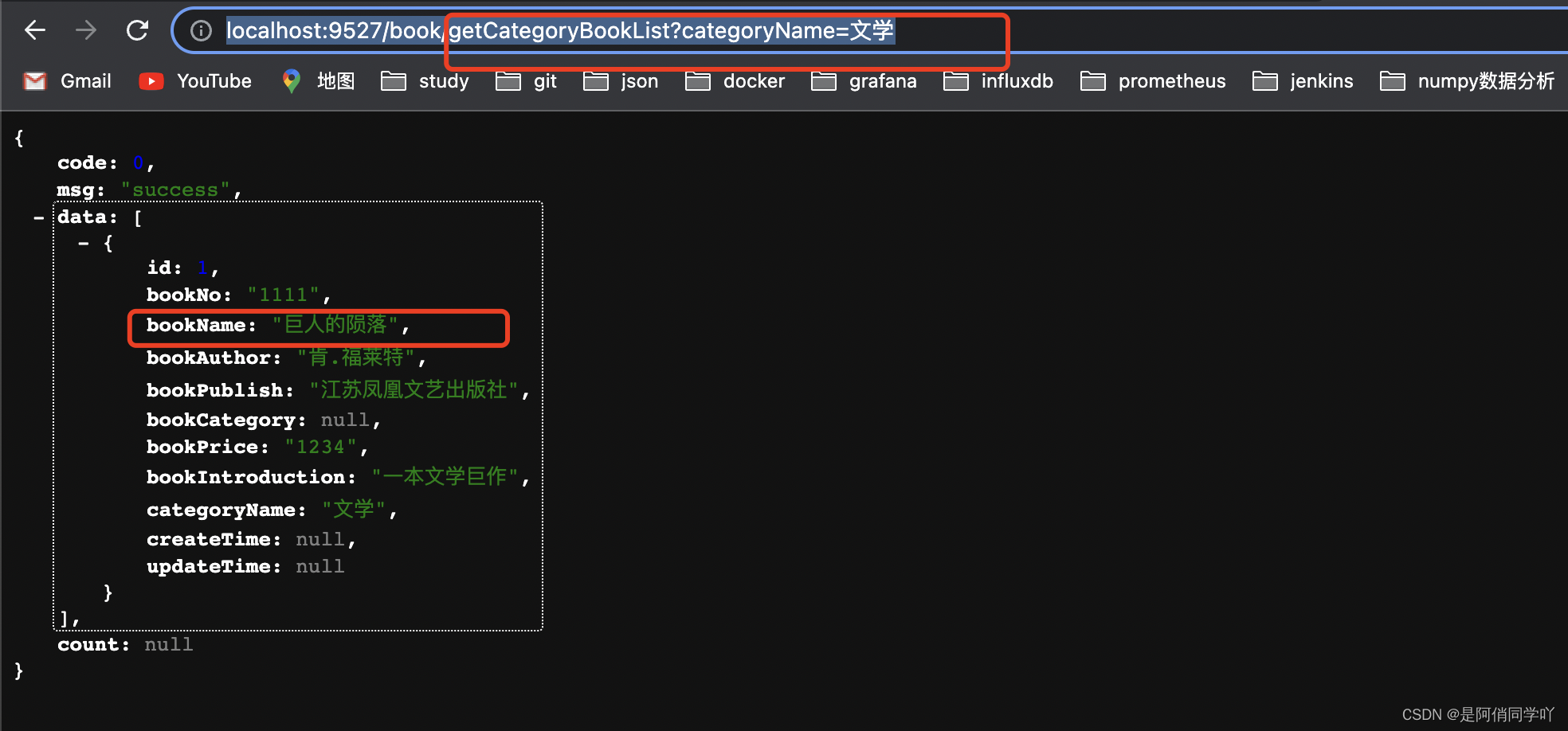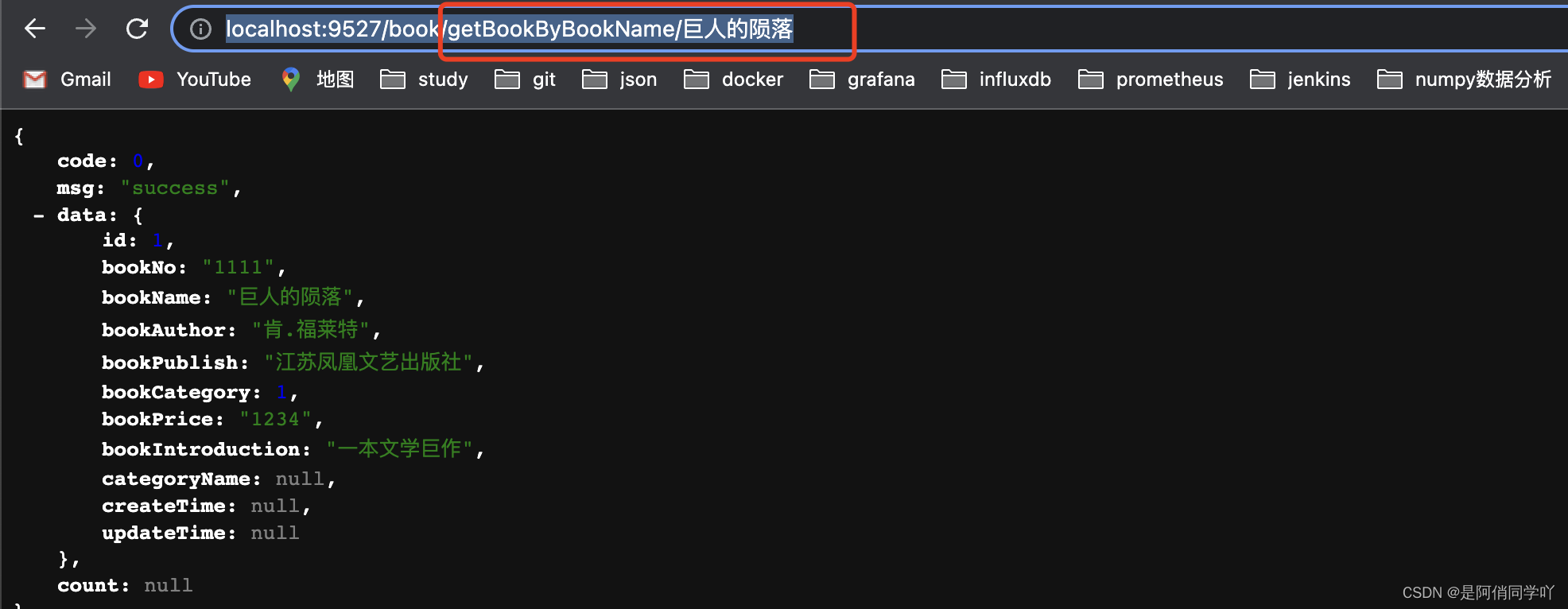前言
在做java接口自动化中,我们常常需要依赖多个接口,A接口依赖B,C,D接口的响应作为请求参数;或者URL中的参数是从其他接口中提取返回值作获取参数这是必不可少的。那么怎么实现呢?下面就来介绍多业务依赖多接口的代码思路。
思路:
1、先new一个HttpClientUtils对象,构造一个queryParam的Map用来放请求参数 ,再构造 一个headers的Map用来放请求头
2、调用get/post请求 获得请求返回值
3、用jsonpath技术, 对A接口中的响应值data取出来
4、遍历获取到的list 然后for循环每条数据
5、close关闭HttpClientUtils对象 释放资源
首先,我们来看下 getCategoryBookList 根据分类名称查询书籍接口 在Controller层代码实现如图所示
/**
* 根据分类名称查询书籍
*
* @return
*/
@GetMapping("/getCategoryBookList")
@ResponseBody
public CommonResponse<List<Book>> getCategoryBookList(@RequestParam(value = "categoryName") String name) {
List<Book> categoryList = bookService.getCategoryBookList(name);
CommonResponse response = CommonResponse.successInstance(categoryList);
return response;
}
代码解释
CommonResponse这个类 是与前端交互用的 因为这个类里面还有请求的statusCode msg
data,如果你想把httpClient调用接口的返回值 返给前端
就将返回值设置到CommonResponse的data中就行@RequestParam(value = "categoryName")如果是问号后面拼的参数 这个用@RequestParam来取,告诉springboot这个name对应的就是参数中的categoryName,就是说前端页面给你传的参数名叫categoryName但是你代码中写的变量名是name如果不加这个参数 是接收不到的 所以需要注解映射CommonResponse.successInstance(categoryList)通用返回值,返回成功message,返回数据data,返回总条数count
其次,我们需要提取/getCategoryBookList接口返回的bookName值

使用JsonPath提取,代码如下
@GetMapping("/returnHttpGet")
@ResponseBody
public CommonResponse returnHttpGet(@RequestParam(value = "categoryName") String categoryName) {
String url = "http://localhost:9527/book/getCategoryBookList";
HttpClientUtils client = new HttpClientUtils(null);
Map<String, String> headers = new HashMap<>();
headers.put("Content-Type", "application/x-www-form-urlencoded");
Map<String, String> queryParam = new HashMap<>();
queryParam.put("categoryName", categoryName);
String result = "";
try {
result = client.get(String.class, url, queryParam, headers);
System.out.println(result);
//使用jsonpath取出响应数据中的bookName值
List<String> bookNames = JsonPath.read(result, "$.data.[*].bookName");
return CommonResponse.successInstance(bookNames);//这个return返回来的值就是个json字符串,可以用jsonpath获取了
client.close();
}
return CommonResponse.errorInstance(result);
}
我们来在浏览器输入URL请求,已经成功提取到了这个bookName值

接下来,我们先看下下一个接口/getBookByBookName在Controler层的代码
/**
* 根据书的名称获取书籍信息
* @param bookName
* @return
*/
@GetMapping("/getBookByBookName/{bookName}")
@ResponseBody
public CommonResponse<Book> getBookByBookName(@PathVariable String bookName){
Book bName = bookService.getBookByBookName(bookName);
CommonResponse response = CommonResponse.successInstance(bName);
return response;
}
代码解释
@PathVariable String bookName@PathVariable是取url中的变量 ,会自动进行赋值拼接在URL后面
将bookName作为getBookByBookName`接口的请求参数,代码如下
String result = "";
try {
result = client.get(String.class, url, queryParam, headers);
System.out.println(result);
//使用jsonpath取出响应数据中的bookName值
List<String> bookNames = JsonPath.read(result, "$.data.[*].bookName");
String bookName = "";
// for (String str : bookNames) {
// bookName = str; 这种遍历我注视掉了 每遍历一次书名就走一次请求 而且遍历出来的书名都不一样
// }
String urls = "http://localhost:9527/getBookByBookName";
HttpClientUtils htp = new HttpClientUtils(null);
Map<String, String> header = new HashMap<>();
headers.put("Content-Type", "application/x-www-form-urlencoded");
Map<String, String> param = new HashMap<>();
param.put("bookName", bookNames.get(0));
String res = "";
try {
//将jsonpath取出的bookName作为请求参数
res = client.get(String.class, urls, param, header);
System.out.println(res);
} catch (Exception e) {
e.printStackTrace();
}
return CommonResponse.successInstance(bookNames);//这个return返回来的值就是个json字符串,可以用jsonpath获取了
} catch (Exception e) {
e.printStackTrace();
} finally {
client.close();
}
return CommonResponse.errorInstance(result);
}
最后我们在浏览器输入URL请求,已经成功返回了第二个接口的返回值

到此就大功告成,完成了HttpClient+JsonPath提取响应值作为多个接口请求参数,解决多业务依赖关联























 778
778











 被折叠的 条评论
为什么被折叠?
被折叠的 条评论
为什么被折叠?








